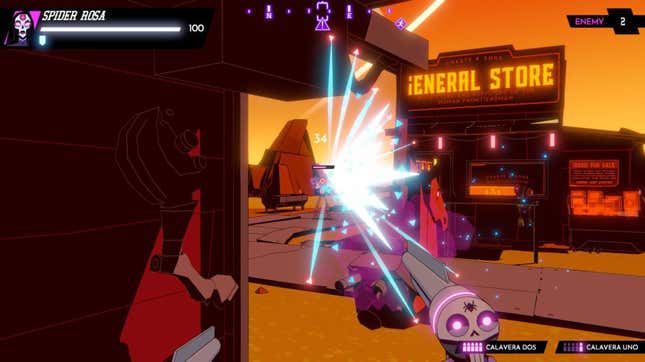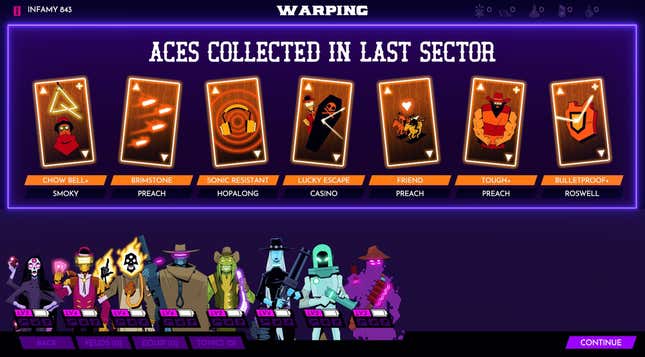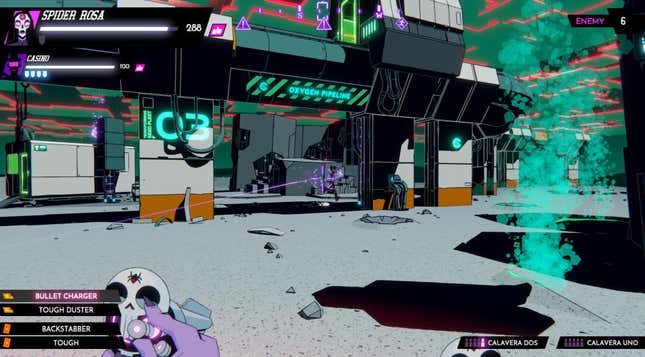Sometimes when you’re looking for a food metaphor for a video game, you’re referring to fine dining. Other times, you’re referring to fast food. In this case, my hackneyed and hackneyed analogy is a big buffet with all your favorite foods, where you just grab handfuls of everything and stuff yourself until you’re sick. It’s fast food at its finest. Wild Bastards.
Apparently a sequel to developer Blue Manchu’s 2019 game Bastards of the Voidbut certainly not a sequel, Wild Bastards is largely an old-school action FPS, with a healthy dose of Kill the arrowand then laced with tactical strategy. It mimics the behavior of a thousand rogue-lites, but it certainly isn’t one, throwing you into super-difficult first-person action sequences that last only a minute or two each and encouraging you to carefully craft elaborate teams of specially-equipped characters, before undoing all your work between chapters. And it all works perfectly.

It’s tempting to spend too much time comparing Wild Bastards to its predecessor, putting checkmarks and crosses next to the aspects it shares and doesn’t share, but I think that detracts from both. And despite the visual similarity, and the fact that both have a branching map of locations leading to FPS-based missions, they are radically different. So let’s focus on what Wild Bastards is, rather than what it is not.
You start the game with two characters, Spider Rosa, a four-armed, slightly demonic creature, and Casino, a gambling robot. The duo are trying to escape the evil and twisted cowboy Chaste family by fleeing across the galaxy in their spaceship. When they teleport to a planet (tutorial) where the two must traverse a map to reach a location that allows them to return to their ship, one of the Chaste, McNeil, destroys the ship and attempts to capture them. At this point, a legendary ship called Drifter arrives and rescues them, forcing them to set off on a journey to recover the life forces of former colleagues killed by the monstrous patriarch Jebediah Chaste. In other words, each chapter of the game consists of reaching the end of a small, branching sector of space to collect the DNA of the dead, then reanimate them and add them to your crew.
Each point on the map of the sector you choose to fly to corresponds to a planet to which you must teleport, and each of these planets has its own map with branches, intersections, points variously filled with pick-ups, shops and, most importantly, battles to win. Each of these battles is a mini-FPS, where you face collections of enemies with your crew. Except that… and bear with me, there is a plot There’s one thing to explain here: your gang travels around a planet in “groups,” grouped one or two, with no more than four selected for each drop. You can group them however you like, but when you fight, only one fights at a time. However, you can switch between party members on the fly. You then have to use your ears (and the game’s visual representation of sound on the compass) to locate enemies, who will hide but constantly give themselves away by shouting insults or talking to each other… Oh my god, this game is so much easier to play than it is to describe.

If a character dies in combat, they are dead until you return to the Drifter and revive them with a rare potion, or you lose everyone and return to the start of the sector, or you succeed without them and move on to the next sector, at which point everyone is revived. Except that in both cases, you also lose all the many pieces of equipment you have earned, purchased or salvaged, and previously assigned to your crew, as well as any money, potions, bonus items or… beans.
Except, or, or, except, but, or, except, and my goodness. I haven’t even gotten to the Ace cards you collect that permanently buff a character, or the Juice you find in battles that lets everyone perform their special ability, or how you want to make sure you pair a long-range one-shot shooter like the furious robot Judge with a faster but less accurate crew member like the mysterious alien Roswell, and if it’s a drop where only three can go, use Casino and his Juice ability to instantly kill the enemy he’s facing, or the ghostly pastor Preach who wields the ridiculously heavy ammo .58 Sermon and has no shield but can use Juice to heal himself when he kills. Oh, but also, if your fight is going to be against a group of Critters rather than humanoids, you’d be crazy to use the snake-like Hopalong and his laser lasso, but he’d be perfect if it was just against a few heavy Ironclads.

I hope I got my point across, even if it was a bit laborious. Wild Bastards is extraordinarily complex, layered upon layered upon layered, with tactics to develop for all of its elements. The character lineup is elaborate, ultimately giving you 12 choices, and even This added layers of complication, as the wonderfully written and voiced crew members will argue at unexpected times, meaning they will refuse to regroup with each other until they reconcile over a plate of… beans. Or they may bond over one of the billion conversations that can take place (I’ve never heard the same one twice) and work better together, supporting each other by throwing objects around the arena.
I also forgot to mention the ever-expanding menagerie of enemies to fight, 25 extraordinary humanoids (Chasteners), 11 animals (Critters), and five types of automated security robots, each with unique behaviors, weapons, and defenses. Not to mention the fact that each mongrel in your team moves subtly differently, some faster, some able to jump higher, one of them quickly sliding on its belly. As I said, this game took something from every section of the buffet and managed to fit it all into one delicious plate.

There are concerns, of course. While the combat is a lot of fun, and even more so thanks to the incredible variety on offer, I find that it lacks the punchy impact of hitting enemies. It often feels like they can walk through your shots unharmed, and there’s no satisfying “whew” when you hit them. It feels a little too ethereal.
The poison is ridiculously overpowered, and the levels with the poison-spewing Rattlers can be miserable to get through until you’ve saved some of the last crew members, with their ongoing damage being far too punishing. The other, much bigger, complaint is that there’s no sweet spot between Normal and Easy. Normal can be a surprisingly difficult choice, especially early on, as the game makes obsessive use of poison when you’re only starting out with two or three characters, and it can be discouraging. But Easy is really easy, and lacks enough of a challenge. (Clearly some people will excel on Hard and Very Hard, and god bless them.) I wish Normal was a little less punishing at first. I recommend switching back to it as you work through the levels, though, as it’s pretty useless.

The other odd decision is forcing you to play through the tutorial every time you play through it. Even with it disabled in the menu, the opening level is still mandatory, and it’s pretty tedious by the time you’re on your third or fourth playthrough (which is much worse for me after playing through the demo of this game multiple times earlier this year).
Oh, but if you’re impatient like me, be aware that pressing Escape will skip the extremely slow beam-up and down sequences and post-battle reports. Never use it in conversations, because they’re all brilliant.
There I barely compared it to the brilliant Bastards of the Void at all, although I encourage you to play both. It is tempting to call Wild Bastards an evolution, but it is unfair for Emptywhich has excellent crafting elements and permanent character death (albeit with persistent progression). What’s crucially similar between the two, beyond the excellent art and fantastic sense of humor, is that unlike so many roguelite games, they’re both I want you to win. It’s about progress, being able to reach an end, and then start all over again to try to do things completely differently. It’s just that in Wild Bastardsthere are so many more things that can be different each time.
.
#Wild #Bastards #SpaceCowboy #Strategy #FPS #dreams